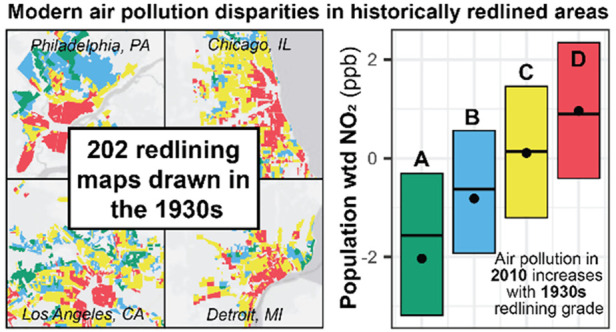- Record: found
- Abstract: found
- Article: found
Historical Redlining Is Associated with Present-Day Air Pollution Disparities in U.S. Cities

Read this article at
Abstract

Communities of color in the United States are systematically exposed to higher levels of air pollution. We explore here how redlining, a discriminatory mortgage appraisal practice from the 1930s by the federal Home Owners’ Loan Corporation (HOLC), relates to present-day intraurban air pollution disparities in 202 U.S. cities. In each city, we integrated three sources of data: (1) detailed HOLC security maps of investment risk grades [A (“best”), B, C, and D (“hazardous”, i.e., redlined)], (2) year-2010 estimates of NO 2 and PM 2.5 air pollution levels, and (3) demographic information from the 2010 U.S. census. We find that pollution levels have a consistent and nearly monotonic association with HOLC grade, with especially pronounced (>50%) increments in NO 2 levels between the most (grade A) and least (grade D) preferentially graded neighborhoods. On a national basis, intraurban disparities for NO 2 and PM 2.5 are substantially larger by historical HOLC grade than they are by race and ethnicity. However, within each HOLC grade, racial and ethnic air pollution exposure disparities persist, indicating that redlining was only one of the many racially discriminatory policies that impacted communities. Our findings illustrate how redlining, a nearly 80-year-old racially discriminatory policy, continues to shape systemic environmental exposure disparities in the United States.
Related collections
Most cited references53
- Record: found
- Abstract: not found
- Article: not found
Chemistry of secondary organic aerosol: Formation and evolution of low-volatility organics in the atmosphere
- Record: found
- Abstract: found
- Article: not found
The Effects of Historical Housing Policies on Resident Exposure to Intra-Urban Heat: A Study of 108 US Urban Areas
- Record: found
- Abstract: not found
- Article: not found